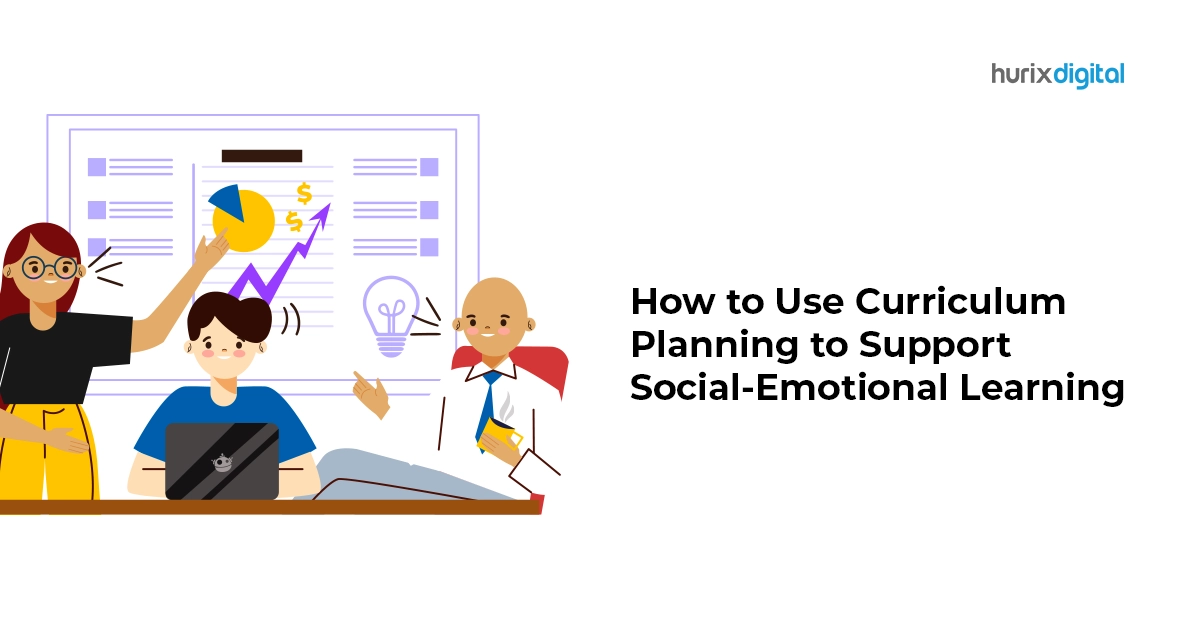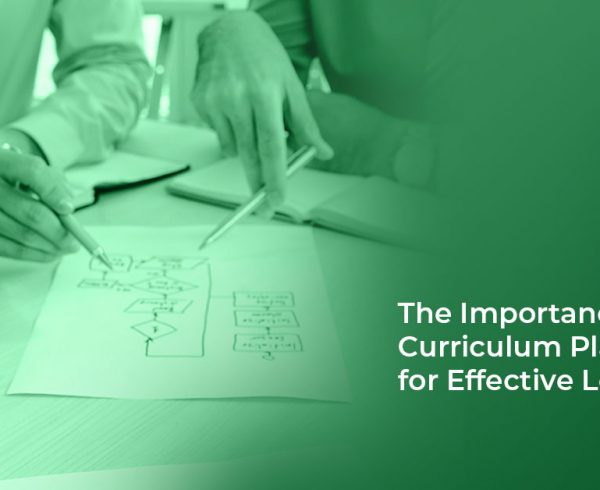Summary
This blog explores how curriculum planning can help integrate SEL into the academic content and foster students' holistic development. It also discussed some of the best practices and challenges of SEL curriculum planning, implementation, and evaluation.
Social-emotional learning (SEL) is the process of developing the skills, attitudes, and behaviors that allow students to control and understand their emotions. It also enables students to sustain and establish positive relationships and helps them make responsible decisions.
SEL has been shown to have positive effects on student’s academic achievement, mental health, and social behavior. According to a meta-analysis of 575,361 students in kindergarten through grade 12, those who participated in SEL programs experienced significantly improved skills, behaviors, attitudes, school climate and safety, school functioning, peer relationships, and academic achievement.
However, SEL is not something that can be taught in isolation or as an add-on to the existing curriculum. To be effective, SEL needs to be integrated into the academic content and the school culture and supported by a coherent and comprehensive curriculum plan.
In this blog, we will explore how curriculum planning can help integrate SEL into the academic content and foster students’ holistic development. We will also discuss some of the best practices and challenges of SEL curriculum planning, implementation, and evaluation.
Table of Contents:
- What Is Social-Emotional Learning? Why Is It Important?
- How to Integrate SEL into Curriculum Planning and Implementation?
- Define the SEL Vision, Mission, and Goals
- Adopt or Adapt an SEL Framework or Model
- Align the SEL Competencies and Standards with the Academic Content and Standards
- Design and Develop the SEL Curriculum and Instruction
- Implement and Monitor the SEL Curriculum and Instruction
- Evaluate and Improve the SEL Curriculum and Instruction
- How to Evaluate the Impact of SEL Curriculum on Students’ Outcomes?
- Conclusion
What Is Social-Emotional Learning? Why Is It Important?
Social-emotional learning (SEL) is the process of developing the skills, attitudes, and behaviors that enable students to understand and manage their emotions, establish and maintain positive relationships, and make responsible decisions.
SEL is based on the premise that learning is not only cognitive but also social and emotional and that these domains are interrelated and influence each other.
SEL is important because it:
- Enhances students’ academic performance, motivation, and engagement
- Improves students’ mental health, well-being, and resilience
- Reduces students’ behavioral problems, such as aggression, bullying, and substance abuse
- Fosters students’ social skills, such as communication, cooperation, and conflict resolution
- Develops students’ character traits, such as empathy, respect, and responsibility
- Prepares students for the challenges and opportunities of the 21st century, such as diversity, globalization, and technology
SEL is not a separate subject or program but a framework that can be integrated into the academic content and the school culture.
SEL skills and concepts can be taught in two ways:
- The first way is explicit, which means using direct instruction and modeling.
- The second way is implicit, which means creating a supportive and caring learning environment.
Both ways also provide opportunities for students to practice and apply the SEL skills and concepts in various contexts and situations.
Now, let’s dive into the details of curriculum planning, implementation, and evaluation.
Also Read: How to Use Educational Games to Promote Social-Emotional Learning in the Classroom
How to Integrate SEL into Curriculum Planning and Implementation?
Here are some of the steps and considerations for integrating SEL into curriculum planning and implementation:
1. Define the SEL Vision, Mission, and Goals
The first step of SEL curriculum implementation is to establish a clear and shared vision, mission, and goals for SEL in the school or district.
This involves articulating the rationale, purpose, and expected outcomes of SEL and how they align with the academic and organizational goals. It also means engaging and communicating with the stakeholders and gaining their support and commitment to SEL.
2. Adopt or Adapt an SEL Framework or Model
It is then necessary to adopt or adapt an SEL framework or model that defines the SEL competencies and standards that students should learn.
There are various SEL frameworks and models available, such as the CASEL’s five core competencies of self-awareness, self-management, social awareness, relationship skills, and responsible decision-making, or the OECD’s four domains of cognitive, emotional, social, and metacognitive skills.
The chosen SEL framework or model should be relevant, comprehensive, and developmentally appropriate for the students and the context.
3. Align the SEL Competencies and Standards with the Academic Content and Standards
After adopting a framework, align the SEL competencies and standards with the academic content and standards and identify the connections and opportunities for integration.
SEL competencies and standards are mapped to academic content and standards, to find areas where they overlap, complement, and enhance.
For example, math content can be integrated with the SEL competency of self-management by teaching students how to set goals, plan strategies, monitor progress, and regulate emotions.
4. Design and Develop the SEL Curriculum and Instruction
The next step is to design and develop the SEL curriculum and instruction and incorporate the SEL competencies and standards into the academic content and instruction.
This means selecting and organizing the SEL content and activities and choosing and implementing the SEL instructional strategies and methods.
For example, the SEL content and activities can include explicit lessons, discussions, role plays, educational games, projects, and reflections. On the other hand, the SEL instructional strategies and methods can include cooperative learning, inquiry-based learning, project-based learning, and problem-based learning.
5. Implement and Monitor the SEL Curriculum and Instruction
Institutions then need to implement and monitor the SEL curriculum and instruction and provide the necessary support and resources for the teachers and students.
Providing professional development and coaching for teachers, as well as creating a positive and supportive learning environment for students, are part of this process.
6. Evaluate and Improve the SEL Curriculum and Instruction
The final step is to evaluate and improve the SEL curriculum and instruction and measure the impact and outcomes of SEL on the students and the school. This involves using various SEL assessment and evaluation tools and methods, such as:
- Surveys
- Observations
- Interviews
- Portfolios
- Performance tasks
- Collecting and analyzing data on the students’ SEL skills, attitudes, behaviors, and academic performance
Furthermore, the data is used to revise and improve SEL curriculum and instruction and to share and celebrate SEL results and achievements.
How to Evaluate the Impact of SEL Curriculum on Students’ Outcomes?
There are different types of SEL assessment and evaluation tools and methods that you can use, depending on your purpose and context. Some of the common ones are:
1. Self-Report Measures
These are surveys or questionnaires that ask students to rate their own SEL competencies, attitudes, and behaviors. Self-report measures are easy to administer and score, but they may be influenced by students’ social desirability, self-awareness, and honesty.
2. Teacher-Report Measures
These are surveys or questionnaires that ask teachers to rate their students’ SEL competencies, attitudes, and behaviors. Teacher-report measures can provide a more objective and comprehensive perspective, but they may be affected by teachers’ biases, expectations, and workload.
3. Performance-Based Measures
These are tasks or scenarios that require students to demonstrate their SEL competencies, such as recognizing emotions, solving problems, or collaborating with others.
Performance-based measures can capture students’ authentic and contextualized SEL skills, but they may be difficult to design, administer, and score.
4. Observational Measures
These are tools or protocols that allow observers to record and rate students’ SEL competencies, attitudes, and behaviors in natural or structured settings. Observational measures can provide rich and detailed data, but they may be time-consuming, subjective, and intrusive.
Also Read: The Importance of Curriculum Planning for Effective Learning
Conclusion
Curriculum planning and implementation for SEL is a powerful and promising way to integrate SEL into your teaching and learning and to foster students’ academic, social, and emotional development.
By following a systematic and collaborative process, you can design and deliver effective and engaging SEL content and courses that align with your goals, standards, and outcomes.
Hurix Digital can help you with curriculum planning and implementation for SEL by providing you with high-quality and innovative digital learning solutions that enhance and enrich your SEL content and courses.
Contact Hurix Digital today to find out how we can help you with your SEL needs.







